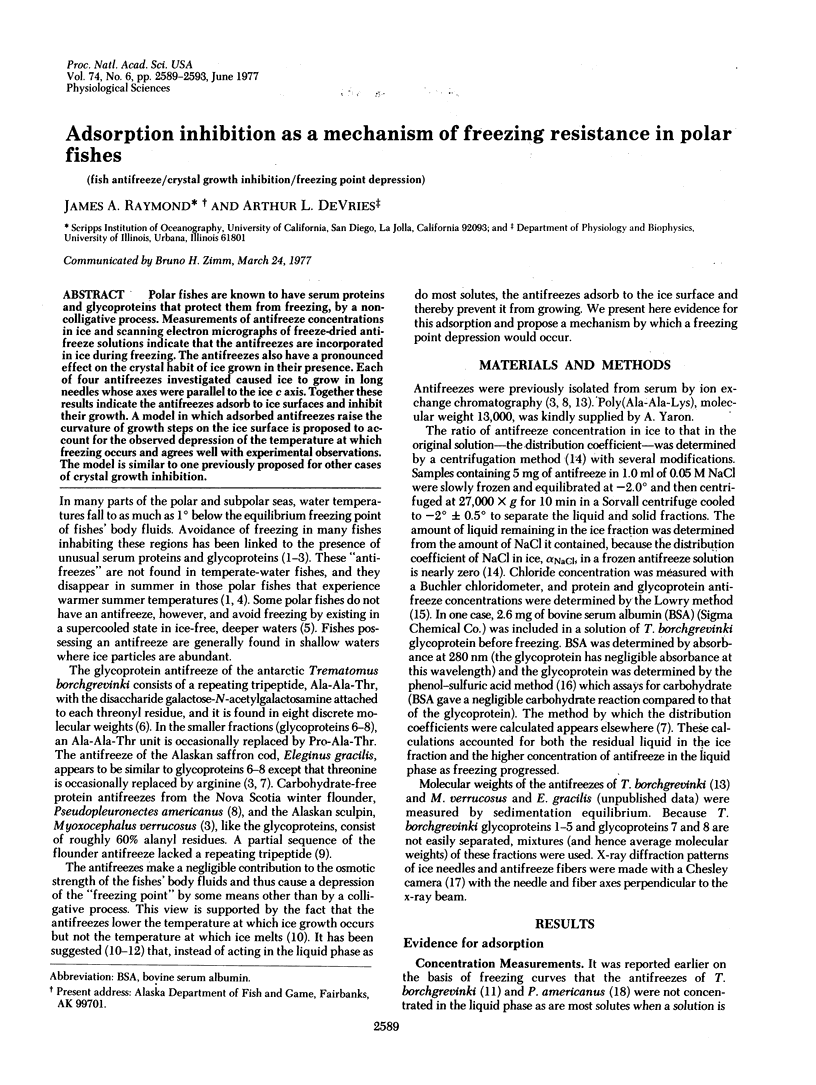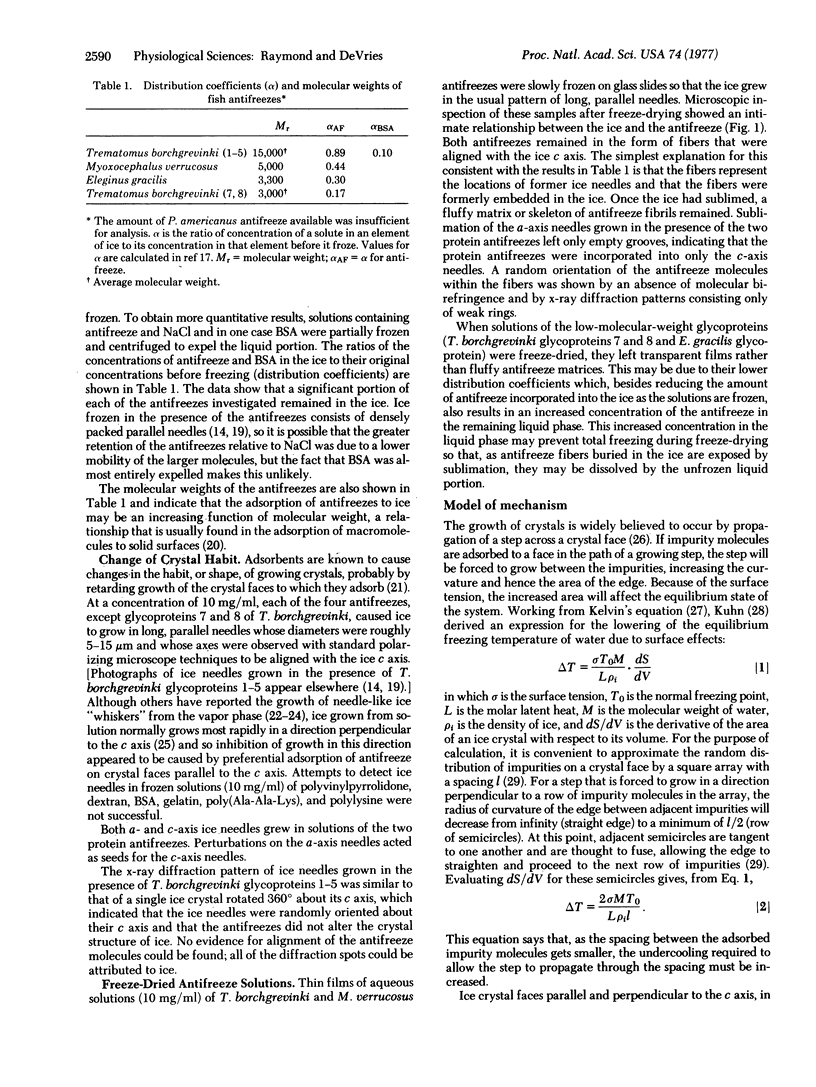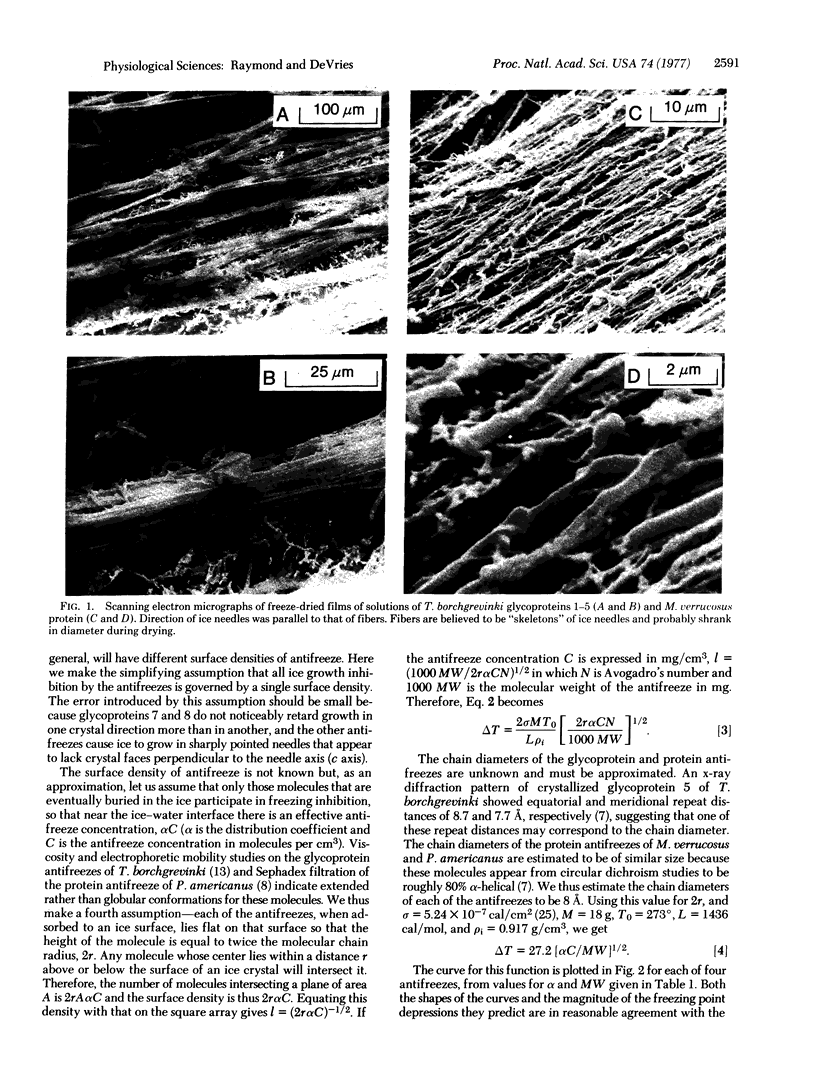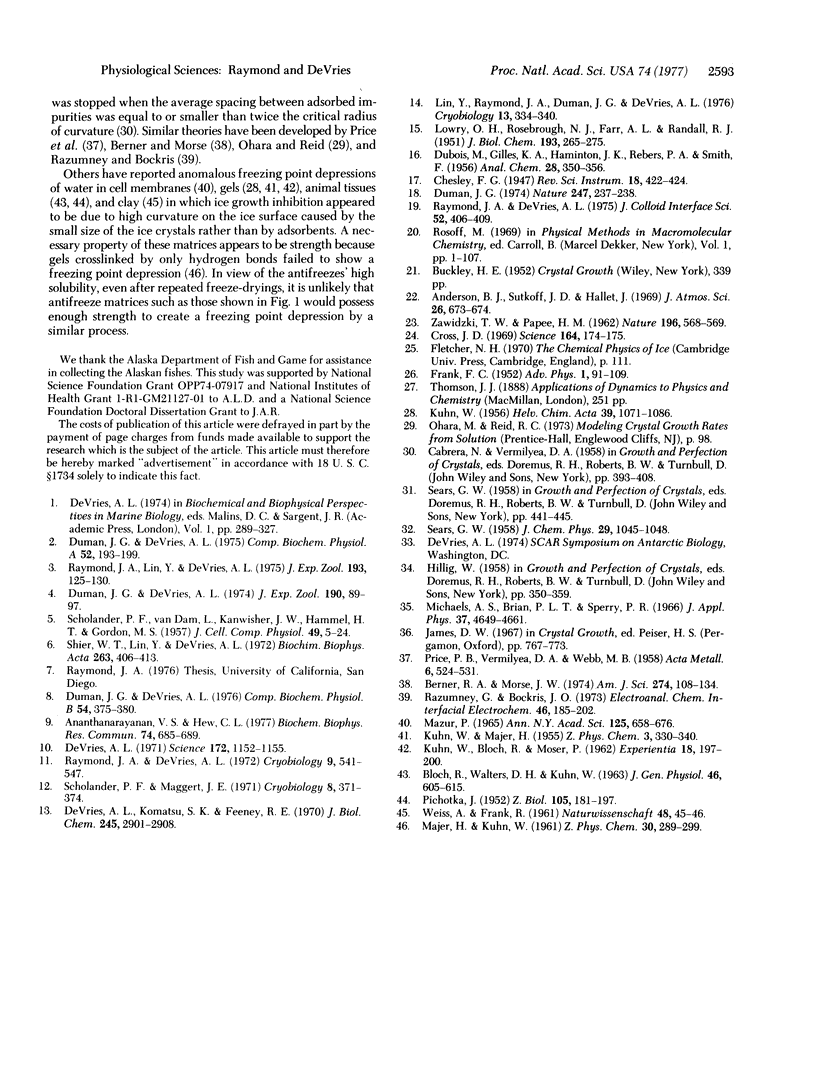Abstract
Polar fishes are known to have serum proteins and glycoproteins that protect them from freezing, by a noncolligative process. Measurements of antifreeze concentrations in ice and scanning electron micrographs of freeze-dried antifreeze solutions indicate that the antifreezes are incorporated in ice during freezing. The antifreezes also have a pronounced effect on the crystal habit of ice grown in their presence. Each of four antifreezes investigated caused ice to grow in long needles whose axes were parallel to the ice c axis. Together these results indicate the antifreezes adsorb to ice surfaces and inhibit their growth. A model in which adsorbed antifreezes raise the curvature of growth steps on the ice surface is proposed to account for the observed depression of the temperature at which freezing occurs and agrees well with experimental observations. The model is similar to one previously proposed for other cases of crystal growth inhibition.
Full text
PDF




Images in this article
Selected References
These references are in PubMed. This may not be the complete list of references from this article.
- Ananthanarayanan V. S., Hew C. L. Structural studies on the freezing-point-depressing protein of the winter flounder Pseudopleuronectes americanus. Biochem Biophys Res Commun. 1977 Jan 24;74(2):685–689. doi: 10.1016/0006-291x(77)90357-6. [DOI] [PubMed] [Google Scholar]
- BLOCH R., WALTERS D. H., KUHN W. Structurally caused freezing point depression of biological tissues. J Gen Physiol. 1963 Jan;46:605–615. doi: 10.1085/jgp.46.3.605. [DOI] [PMC free article] [PubMed] [Google Scholar]
- Cross J. D. Scanning electron microscopy of evaporating ice. Science. 1969 Apr 11;164(3876):174–175. doi: 10.1126/science.164.3876.174. [DOI] [PubMed] [Google Scholar]
- DeVries A. L. Glycoproteins as biological antifreeze agents in antarctic fishes. Science. 1971 Jun 11;172(3988):1152–1155. doi: 10.1126/science.172.3988.1152. [DOI] [PubMed] [Google Scholar]
- DeVries A. L., Komatsu S. K., Feeney R. E. Chemical and physical properties of freezing point-depressing glycoproteins from Antarctic fishes. J Biol Chem. 1970 Jun 10;245(11):2901–2908. [PubMed] [Google Scholar]
- Duman J. G., DeVries A. L. The effects of temperature and photoperoid on antifreeze production in cold water fishes. J Exp Zool. 1974 Oct;190(1):89–98. doi: 10.1002/jez.1401900108. [DOI] [PubMed] [Google Scholar]
- Duman J. G., DeVries A. L. The role of macromolecular antifreezes in cold water fishes. Comp Biochem Physiol A Comp Physiol. 1975 Sep 1;52(1):193–199. doi: 10.1016/s0300-9629(75)80152-6. [DOI] [PubMed] [Google Scholar]
- Duman J. G., de Vries A. L. Isolation, characterization, and physical properties of protein antifreezes from the winter flounder, Pseudopleuronectes americanus. Comp Biochem Physiol B. 1976;54(3):375–380. doi: 10.1016/0305-0491(76)90260-1. [DOI] [PubMed] [Google Scholar]
- LOWRY O. H., ROSEBROUGH N. J., FARR A. L., RANDALL R. J. Protein measurement with the Folin phenol reagent. J Biol Chem. 1951 Nov;193(1):265–275. [PubMed] [Google Scholar]
- Lin Y., Raymond J. A., Duman J. G., DeVries A. L. Compartmentalization of NaCl in frozen solutions of antifreeze glycoproteins. Cryobiology. 1976 Jun;13(3):334–340. doi: 10.1016/0011-2240(76)90115-2. [DOI] [PubMed] [Google Scholar]
- Mazur P. The role of cell membranes in the freezing of yeast and other single cells. Ann N Y Acad Sci. 1965 Oct 13;125(2):658–676. doi: 10.1111/j.1749-6632.1965.tb45420.x. [DOI] [PubMed] [Google Scholar]
- PICHOTKA J. Untersuchungen über Gefrierpunkte des lebenden Gewebes. Z Biol. 1952;105(3):181–197. [PubMed] [Google Scholar]
- Raymond J. A., DeVries A. L. Freezing behavior of fish blood glycoproteins with antifreeze properties. Cryobiology. 1972 Dec;9(6):541–547. doi: 10.1016/0011-2240(72)90176-9. [DOI] [PubMed] [Google Scholar]
- Raymond J. A., Lin Y., DeVries A. L. Glycoprotein and protein antifreezes in two Alaskan fishes. J Exp Zool. 1975 Jul;193(1):125–130. doi: 10.1002/jez.1401930112. [DOI] [PubMed] [Google Scholar]
- Scholander P. F., Maggert J. E. Supercooling and ice propagation in blood from Arctic fishes. Cryobiology. 1971 Aug;8(4):371–374. doi: 10.1016/0011-2240(71)90133-7. [DOI] [PubMed] [Google Scholar]
- Shier W. T., Lin Y., De Vries A. L. Structure and mode of action of glycoproteins from an antarctic fish. Biochim Biophys Acta. 1972 Apr 15;263(2):406–413. doi: 10.1016/0005-2795(72)90092-x. [DOI] [PubMed] [Google Scholar]






